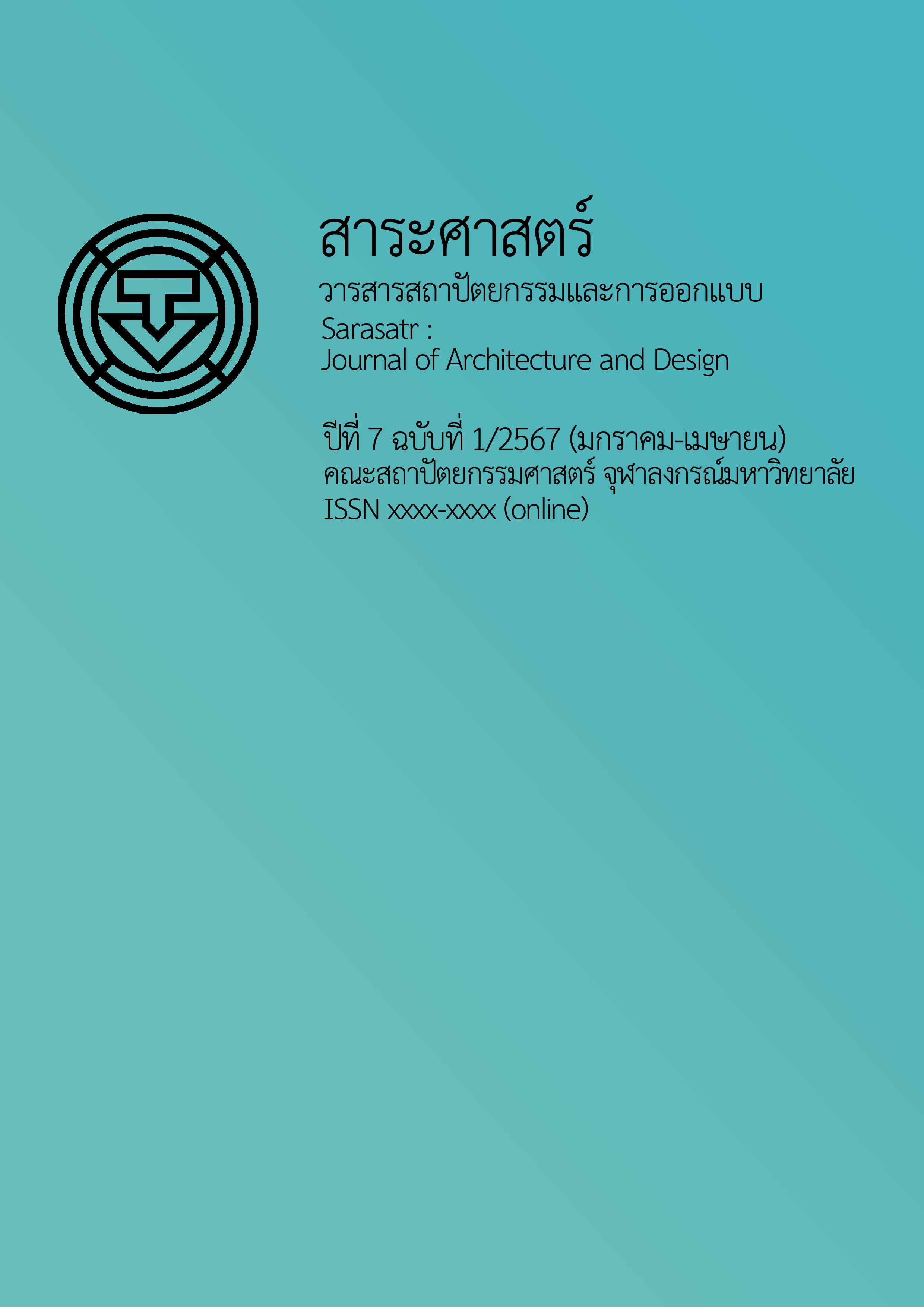Mode Choice for Children’s School Trips: A Case Study on Independent Mobility in Schools Proximate to Mass Transit Stations in Bangkok, Thailand
Main Article Content
บทคัดย่อ
Transit-oriented development (TOD) is essential to promote independent travel and encourage mass transit use among students, which has several advantages for their physical well-being and boosts their confidence in society. Despite a decade of mass rail transit development and TOD development in Bangkok, cars still queue to drop students at schools, even near transit stations. This presents a paradox: Why do students go to school in proximity to the mass transit system but not use the mass transit system? The high reliance on personal cars will inevitably shape children’s transportation habits in adulthood, significantly impacting the city’s air quality and exacerbating environmental pollution and traffic conditions. This research builds on the necessity for students attending schools near mass transit stations to use public transportation more.
This study reveals critical factors influencing school trips, including safety concerns, parental permission, and travel costs. Notably, children’s independence levels from their parents affect their mode choice and the frequency of using mass transit for school trips. The socioeconomic, demographic, trip characteristics, and transportation traits explain students’ high reliance on private cars.
A significant finding of this study underscores the enduring impact of the typical lifestyle of Thai households and their strong reliance on private cars on travel behavior in Bangkok. The outcomes of this study provide valuable insights for urban strategic policies, advocating and encouraging students to use mass transit for school trips and normalizing its usage. This study holds potential benefits for BTS, MRT companies, and the Bangkok metropolitan administration in achieving their goal to promote mass transit.
Article Details
เอกสารอ้างอิง
BEM Bangkok Expressway and Metro. (n.d.). https://metro.bemplc.co.th/MRT-System-Line?pid=3&lang=en
BTS Skytrain. (n.d.). https://www.bts.co.th/eng/info/info-history.html
Charoentrakulpeeti, W., Sajor, E., & Zimmermann, W. (2006). Middle‐class travel patterns, predispositions and attitudes, and present-day transport policy in Bangkok, Thailand. Transport Reviews, 26(6), 693-712. https://doi.org/10.1080/01441640600746927
Daquila, T. C. (2005). The economies of Southeast Asia: Indonesia, Malaysia, Philippines, Singapore and Thailand. Nova Publishers.
Drianda, R. P., & Kinoshita, I. (2011). Danger from traffic to fear of monkeys: Children’s independent mobility in four diverse sites in Japan. Global Studies of Childhood, 1(3), 226-242.
Fyhri, A., & Hjorthol, R. (2009). Children’s independent mobility to school, friends and leisure activities. Journal of Transport Geography, 17(5), 377-384. https://doi.org/10.1016/j.jtrangeo.2008.10.010
Hendrigan, C., & Newman, P. (2017). Dense, mixed-use, walkable urban precinct to support sustainable transport or vice versa? A model for consideration from Perth, Western Australia. International Journal of Sustainable Transportation, 11(1), 11-19. https://doi.org/10.1080/15568318.2015.1106225
Le, T. P. L., & Trinh, T. A. (2016). Encouraging public transport use to reduce traffic congestion and air pollutant: A case study of Ho Chi Minh City, Vietnam. Procedia Engineering, 142, 236-243. https://doi.org/https://doi.org/10.1016/j.proeng.2016.02.037
Mahlawat, M., Rayan, S., Kuchangi, S., Patil, S., & Burris, M. W. (2007, January 21-25). Examination of student travel mode choice [Paper presentation]. Transportation Research Board 86th Annual Meeting, Washington, DC.
Manifesty, O., & Park, J. (2022). A case study of a 15-minute city concept in Singapore’s 2040 land transport master plan: 20-minute towns and a 45-minute city. International Journal of Sustainable Transportation Technology, 5, 1-11. https://doi.org/10.31427/IJSTT.2022.5.1.1
Nguyen-Phuoc, D. Q., Amoh-Gyimah, R., Tran, A. T. P., & Phan, C. T. (2018). Mode choice among university students to school in Danang, Vietnam. Travel Behaviour and Society, 13, 1-10. https://doi.org/https://doi.org/10.1016/j.tbs.2018.05.003
Phang, S.-Y. (1993). Singapore’s motor vehicle policy: Review of recent changes and a suggested alternative. Transportation Research Part A: Policy and Practice, 27(4), 329-336. https://doi.org/https://doi.org/10.1016/0965-8564(93)90005-6
Pongprasert, P., & Kubota, H. (2017). Why TOD residents still use car? Understanding the factors affecting the automobile ownership and use of residents living near transit stations of Bangkok. Urban and Regional Planning Review, 4, 231-250.
Shannon, T., Giles-Corti, B., Pikora, T., Bulsara, M., Shilton, T., & Bull, F. (2006). Active commuting in a university setting: Assessing commuting habits and potential for modal change. Transport Policy, 13(3), 240-253. https://doi.org/https://doi.org/10.1016/j.tranpol.2005.11.002
Waygood, E. O. D., & Friman, M. (2015). Children’s travel and incidental community connections. Travel Behaviour and Society, 2(3), 174-181. https://doi.org/10.1016/j.tbs.2015.03.003
Waygood, E. O. D., & Kitamura, R. (2009). Children in a rail-based developed area of Japan: Travel patterns, independence, and exercise. Transportation Research Record, 2125(1), 36-43. https://doi.org/10.3141/2125-05
Witchayaphong, P., Pravinvongvuth, P. D. S., Kanitpong, K., Sano, K., & Horpibulsuk, S. (2020). Influential factors affecting travelers’ mode choice behavior on mass transit in Bangkok, Thailand. Sustainability, 12, 9522. https://doi.org/10.3390/su12229522


